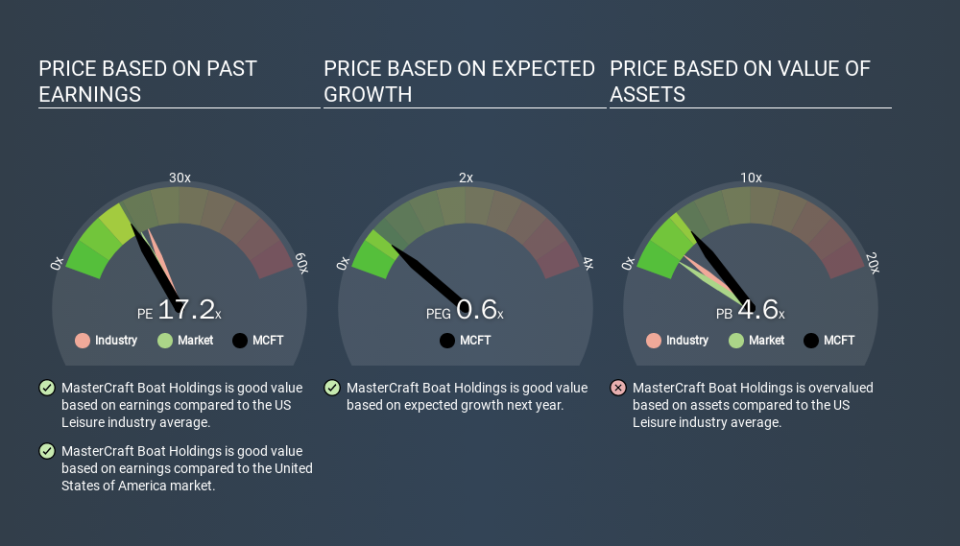A Rising Share Price Has Us Looking Closely At MasterCraft Boat Holdings, Inc.'s (NASDAQ:MCFT) P/E Ratio

MasterCraft Boat Holdings (NASDAQ:MCFT) shares have had a really impressive month, gaining 31%, after some slippage. But shareholders may not all be feeling jubilant, since the share price is still down 15% in the last year.
All else being equal, a sharp share price increase should make a stock less attractive to potential investors. In the long term, share prices tend to follow earnings per share, but in the short term prices bounce around in response to short term factors (which are not always obvious). The implication here is that deep value investors might steer clear when expectations of a company are too high. One way to gauge market expectations of a stock is to look at its Price to Earnings Ratio (PE Ratio). Investors have optimistic expectations of companies with higher P/E ratios, compared to companies with lower P/E ratios.
Check out our latest analysis for MasterCraft Boat Holdings
Does MasterCraft Boat Holdings Have A Relatively High Or Low P/E For Its Industry?
MasterCraft Boat Holdings's P/E of 17.19 indicates relatively low sentiment towards the stock. The image below shows that MasterCraft Boat Holdings has a lower P/E than the average (20.8) P/E for companies in the leisure industry.
This suggests that market participants think MasterCraft Boat Holdings will underperform other companies in its industry. While current expectations are low, the stock could be undervalued if the situation is better than the market assumes. It is arguably worth checking if insiders are buying shares, because that might imply they believe the stock is undervalued.
How Growth Rates Impact P/E Ratios
Earnings growth rates have a big influence on P/E ratios. When earnings grow, the 'E' increases, over time. That means even if the current P/E is high, it will reduce over time if the share price stays flat. So while a stock may look expensive based on past earnings, it could be cheap based on future earnings.
MasterCraft Boat Holdings shrunk earnings per share by 48% over the last year. But EPS is up 4.7% over the last 3 years. And over the longer term (5 years) earnings per share have decreased 9.1% annually. This might lead to muted expectations.
A Limitation: P/E Ratios Ignore Debt and Cash In The Bank
It's important to note that the P/E ratio considers the market capitalization, not the enterprise value. Thus, the metric does not reflect cash or debt held by the company. Theoretically, a business can improve its earnings (and produce a lower P/E in the future) by investing in growth. That means taking on debt (or spending its cash).
Spending on growth might be good or bad a few years later, but the point is that the P/E ratio does not account for the option (or lack thereof).
How Does MasterCraft Boat Holdings's Debt Impact Its P/E Ratio?
MasterCraft Boat Holdings's net debt equates to 29% of its market capitalization. You'd want to be aware of this fact, but it doesn't bother us.
The Verdict On MasterCraft Boat Holdings's P/E Ratio
MasterCraft Boat Holdings's P/E is 17.2 which is about average (18.5) in the US market. When you consider the lack of EPS growth last year (along with some debt), it seems the market is optimistic about the future for the business. What we know for sure is that investors have become more excited about MasterCraft Boat Holdings recently, since they have pushed its P/E ratio from 13.1 to 17.2 over the last month. For those who prefer to invest with the flow of momentum, that might mean it's time to put the stock on a watchlist, or research it. But the contrarian may see it as a missed opportunity.
Investors should be looking to buy stocks that the market is wrong about. If it is underestimating a company, investors can make money by buying and holding the shares until the market corrects itself. So this free visualization of the analyst consensus on future earnings could help you make the right decision about whether to buy, sell, or hold.
Of course, you might find a fantastic investment by looking at a few good candidates. So take a peek at this free list of companies with modest (or no) debt, trading on a P/E below 20.
If you spot an error that warrants correction, please contact the editor at editorial-team@simplywallst.com. This article by Simply Wall St is general in nature. It does not constitute a recommendation to buy or sell any stock, and does not take account of your objectives, or your financial situation. Simply Wall St has no position in the stocks mentioned.
We aim to bring you long-term focused research analysis driven by fundamental data. Note that our analysis may not factor in the latest price-sensitive company announcements or qualitative material. Thank you for reading.

 Yahoo Movies
Yahoo Movies 

